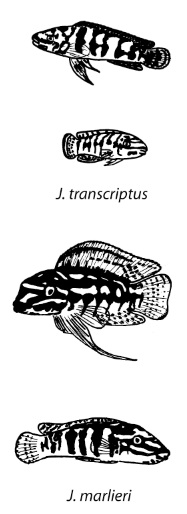Department of Biology
Renn Lab
Student Project Ideas
(check back often as new ideas will be added)
(see previous ideas, some of which are still viable)
These pages include scientific ideas that supplement my own research interests. I provide a short summary and a few references but students are encouraged to propose independent ideas.
3. GENDER BIASED BEHAVIOR: AFRICANC CIHCHLIDS Julidochromis(detail):
The unparalleled diversity of cichlid fish behavior represented among the African rift lakes is the result of evolutionary radiation. The phenotypes are adaptive, having been sculpted through natural and sexual selection and many also show plasticity on a more rapid timescale. Therefore cichlid fishes present an opportunity to understand how genomic variation (regulatory and structural) and behavioral plasticity influence the evolution of behavior In contrast to the uniformly polygamous mating strategy employed by the haplochromine cichlids from Lake Malawi and Lake Victoria, cichlids within Lake Tanganyika include monogamous polygous, and polyandrous species that brood their young in their mouths or on solid substrate. The labile evolution of mating strategy of this species group provides a unique opportunity to address molecular and genetic basis this variation. In the lab we currently have ~ 8 species but others are available. George Barlow has written a fantastic, fun reference that covers many of the extraordinary behaviors of these fish.
3.A) Sex-Role Reversal *
The African Cichlid fishes provide a unique opportunity to observe naturalistic behaviors in which gender-biased behaviors can be reversed by either environmental effects or genetic effects. Among the genus Julidochromis, there are 5 monogamous species, 3 of which naturally exhibit sex-role conventional behavior and two of which exhibit sex-role reversed behavior. Within the conventional sex-role species the males are larger, more aggressive and territorial, while the females provide the egg care and nest maintenance while in a closely related species the sex-role behaviors are reversed by genetic background. In either species, altering the social environment, will reverse sex-role behaviors. These behavioral phenotypes as well as hormone levels and gene expression profiles can be assessed in each situation in order to investigate the mechanism that underlie genetic and environmental influences on behavior.
3.B) RNA-seq may replace Microarray analysis. Are we ready?
We aim to employ cutting edge "next-gen sequencing" platforms to determine to which extent species-specific social organization is the result of evolutionary changes in protein sequence variation or changes in the regulation of gene expression (a highly contentious issue in modern biology). Our previous work has relied upon microarray technology which does not provide gene sequence information, only relative expression level information. By generating transcriptome data with "next-gen sequencing" (a technique known as RNA-seq) we will obtain comparative coding sequence data as well as gene expression counts. This is an unproven technology for "non-model species" for which full genome sequence is not available to use as a "reference". While we hope to have full genome sequence for Tilapia soon, it is ~ 10 MY diverged from the cichlid species of interest. Therefore, we need to devise new algorithms for DNA sequence alignment that can handle the quantity and quality of data obtain by next-gen sequencing platforms with the added difficulty of a diverged "reference genome". Projects in this will require collaboration with computer scientists here at Reed as well as with members of the Chang lab at Oregon State University. (For recent reviews see Wang et al 2009; Trapnell & Salzber 2009)
1. GENOME EVOLUTION (details):
1.A) Gene Duplication of Genomic Architecture of Adaptive Radiation *
1.B) Bioinformatic Analysis of Cichlid Genomes
2. MATERNAL BEHAVIOR: AFRICAN CICHLID Astatotilapia burtoni (details):
2.A) The Effect of Early Experience on Adult Behavior
2.B) The Influence of Metabolic Regulation on Maternal Behavior *
2.C) The Social Neural Circuit *
2.D) The Emergence of Leadership
3. GENDER BIASED BEHAVIOR: AFRICANC CIHCHLIDS Julidochromis(details):
3.A) Sex-Role Reversal *
3.B) RNA-seq may replace Microarray analysis. Are we ready?
(* indicates ongoing projects that are a main focus in our funded research programs)

